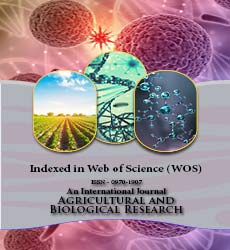Agricultural and Biological Research
RNI # 24/103/2012-R1
Worku Teshome, Endalkachew Fekadu* and Haile Getnet
Land use and land cover changes have contributed to land degradation that result from unsustainable agricultural practices. Hence, this assessment was done to evaluate land use land cover changes and their impacts on the properties of soils in the Sdeyni micro-watershed in Northeastern Ethiopia. Satellite images for the periods of 1984, 2000 and 2020 were gathered to evaluate the land use changes. Cultivated land, forest land and grassland were selected to determine their effects on soil properties. Eighteen disturbed composite and 18 undisturbed core soil samples were collected from the selected three land use types at two depths with three replications. The result showed that within 36 years, the overall pattern of forest land declined by 188 ha (1.79%) from 1984-2020 with an annual rate of 0.47% due to the conversion of forest lands to cultivated and grasslands. The forest and grasslands were decreased by 1.8 and 6.7%, respectively, relative to the starting year. Contrary to this, an increase in the size of cultivated and settlement lands were detected by 5.1 and 3.6%, respectively, compared to 1984. In all land uses, bulk density increased with depth, where the highest value was obtained in the cultivated lands. Across land uses, soil pH varied from 5.57 to 6.93 and it was found in a moderately acidic soil reaction. Significantly higher contents of OC, total N and available P were obtained on the surface soil of the forest lands. Exchangeable bases and CEC showed significant differences among land use types and soil depths. All the analyzed bases were more concentrated in the subsoil of the forest lands, whereas the lowest values were observed on the cultivated lands. Therefore, it indicates that the Sdeyni watershed required immediate interventions and sustainable land management to protect the forest lands and improve agricultural productivity. Application of organic materials and chemical fertilizers and amendments should be improved on cultivated lands.
